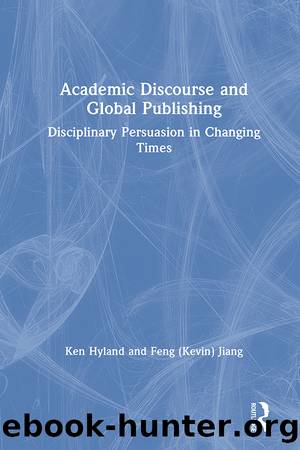Academic Discourse and Global Publishing by Hyland Ken;Jiang Feng (Kevin);

Author:Hyland, Ken;Jiang, Feng (Kevin);
Language: eng
Format: epub
Publisher: Taylor & Francis Group
Published: 2019-10-15T00:00:00+00:00
8.3 Searching for stance
Going back to the corpus we have used throughout this book, we searched for stance features using the concordance software AntConc (Anthony, 2018). We followed Hylandâs (2005b) approach to stance in academic writing which regards it as:
writer-oriented features of interaction and refers to the ways academics annotate their texts to comment on the possible accuracy or credibility of a claim, the extent they want to commit themselves to it, or the attitude they want to convey to an entity, a proposition, or the reader. (Hyland, 2005b: 178)
Stance comprises only half of Hylandâs model of intersubjective positioning (the other half, engagement, is examined in Chapter 10); it nevertheless represents a coherent concept and body of research. This framework encompasses three main components: evidentiality, affect and presence.
Evidentiality â the writerâs stated commitment to the reliability of the propositions he or she presents and their potential impact on the reader, expressed through hedges and boosters.
Affect â a broad range of personal and professional attitudes towards what is said expressed through attitude markers.
Presence â concerns the extent to which the writer chooses to intrude into a text through the use of first-person pronouns and possessive determiners.
Download
This site does not store any files on its server. We only index and link to content provided by other sites. Please contact the content providers to delete copyright contents if any and email us, we'll remove relevant links or contents immediately.
Periodization Training for Sports by Tudor Bompa(7329)
The MacArthur Bible Commentary by John MacArthur(4238)
The Body: A Guide for Occupants by Bill Bryson(3802)
The Sports Rules Book by Human Kinetics(3588)
What It Really Takes to Get Into Ivy League and Other Highly Selective Colleges by Hughes Chuck(3221)
Marijuana Grower's Handbook by Ed Rosenthal(3119)
The Sprouting Book by Ann Wigmore(3053)
Salt, Fat, Acid, Heat: Mastering the Elements of Good Cooking by Nosrat Samin(2658)
The Martian by Andy Weir(2611)
Classic by Mary Berry(2501)
The Bread Bible by Rose Levy Beranbaum(2472)
Harry Potter 4 - Harry Potter and The Goblet of Fire by J.K.Rowling(2416)
Sapiens and Homo Deus by Yuval Noah Harari(2415)
The Marketing Plan Handbook: Develop Big-Picture Marketing Plans for Pennies on the Dollar by Robert W. Bly(2414)
Martha Stewart's Baking Handbook by Martha Stewart(2332)
50 Economics Classics by Tom Butler-Bowdon(2066)
Screenplay: The Foundations of Screenwriting by Syd Field(2057)
The Cambridge Grammar Of The English Language by Rodney Huddleston Geoffrey K. Pullum(2048)
The Plant Paradox by Dr. Steven R. Gundry M.D(2040)
